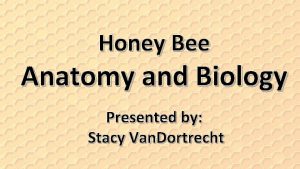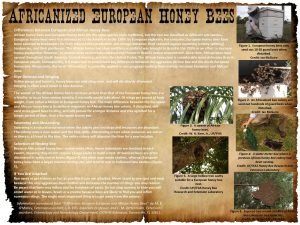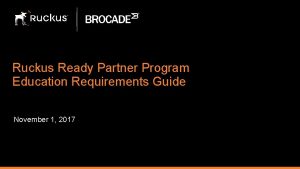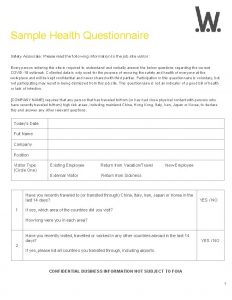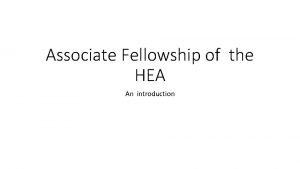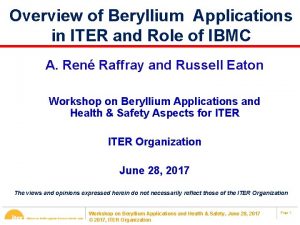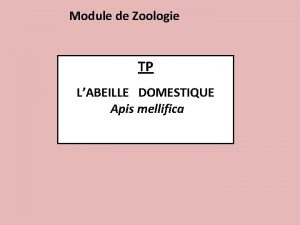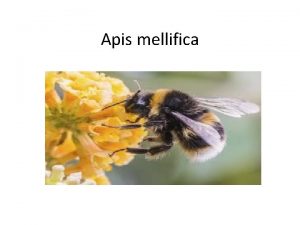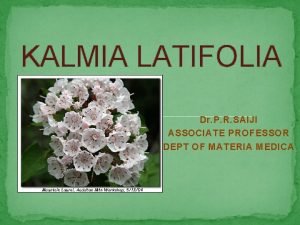APIS MELLIFICA Dr P R SAIJI ASSOCIATE PROFESSOR



































































- Slides: 67

APIS MELLIFICA Dr. P. R. SAIJI ASSOCIATE PROFESSOR DEPT OF MATERIA MEDICA

SCIENTIFIC CLASSIFICATION Kingdom: Animalia � Phylum: Arthropoda � Class: Insecta � Order: Hymenoptera � Family: Apidae � Genus: Apis � Species: A. mellifera � Zoological name: Apis mellifera �

PHYLUM: ARTHROPODA � Segmented body (2 or 3 regions) � Paired segmented appendages � Exoskeleton � Bilaterally symmetrical with tubular alimentary canal � Open circulatory system (dorsal blood vessel and open body cavity) � Invertebrates

CLASS: INSECTA (Over 1, 000 species can be found around your home � Head, thorax, abdomen � One pair of antennae � 3 pairs of legs � 1 or 2 pairs of wings

ORDER: HYMENOPTERA � Clear membrane like wings � Includes social insects � Constricted abdomen � Do not damage plants by direct feeding Super family: apoidea � Branched body hairs � Special body hairs for pollen transport � Plant pollen and nectar sole source of food

FAMILY: APIDAE � Includes honey bee and bumble bee � Most are eusocial � Cooperative brood care � Reproductive castes � Generation overlap Genus: apis � 6 species (includes apis mellifera)

The western honey bee or European honey bee (Apis mellifera) is the most common of the ~40 species of honey bee worldwide. � The genus name Apis is Latin for "bee", and mellifera means "honey-bearing", referring to the species' tendency to produce a large quantity of honey for storage over the winter. � Like all honey bees, the western honey bee is eusocial, creating colonies with a single fertile female (or "queen") many sterile females or "workers", and small proportion of fertile males or "drones". �

� Individual colonies can house tens of thousands of bees. Colony activities are organized by complex communication between individuals, through both odors and the dance language. � The western honey bee was one of the first domesticated insects, and is the primary species maintained by beekeepers to this day for both its honey and pollination services.

With human assistance, the western honey bee now occupies every continent except Antarctica. Due to its wide cultivation, this species is the single most important pollinator for agriculture globally. A number of pests and diseases threaten the honey bee, especially colony collapse disorder. � Western honey bees are an important model organism in scientific studies, particularly in the fields of social evolution, learning and memory; they are also used in studies of pesticide toxicity, to assess non-target impacts of commercial pesticides. �

GEOGRAPHIC DISTRIBUTION � � � The western honey bee is native to Europe, Asia and Africa. During the early 1600 s it was introduced to North America, with other European subspecies introduced two centuries later. Since then, it has spread throughout the Americas. Western honey bees evolved into geographic races as they spread from Africa into Eurasia, and 28 subspecies based on these geographic variations are recognized. All races are cross-fertile, although reproductive adaptations may make interbreeding unlikely. The subspecies are divided into four major branches, based on work by Ruttner and confirmed by mitochondrial DNA analysis.

GEOGRAPHIC DISTRIBUTION � � African subspecies belong to branch A, northwestern European subspecies branch M, southwestern European subspecies branch C and Mideastern subspecies branch O. Regions with local variations may be identified as subspecies in the future. Geographic isolation led to adaptation as honey bees spread after the last ice age. These adaptations include brood cycles synchronized to the blooming period of local flora, forming a winter cluster in colder climates, migratory swarming in Africa and enhanced foraging behavior in desert areas.

BIOLOGY AND LIFE CYCLE

BIOLOGY AND LIFE CYCLE

EGGS

EGGS AS SEEN IN CROSS-SECTION OF CELLS.

LARVAE

BIOLOGY AND LIFE CYCLE

BIOLOGY AND LIFE CYCLE

EGG NOT (parthenog enesis) FERTILIZED? WELL-FED? QUEEN NOT WORKER MALE

BEE TYPES WITHIN COLONY Queen Drone Worker

THE QUEEN � � � She is longer than the worker bee. Her wings are disproportionately short and her abdomen disproportionately large. The only job of mated queen is to lay eggs 800 (typical) to 2000 per day. Although it may appear that the worker bees around her are “waiting upon her, ” the fact is that they are feeding her so she stays on the brood comb laying eggs. They herd her around like a cow keeping her working 365 x 24 x 7. There is only one queen in a colony. It is difficult to find the queen in the colony. Mating takes place 200 to 300 ft. in the air.

• • After mating, the drone loses his reproduction organ (barbed) in the queen and he dies. Only about 1% of the drones get to mate. Over several mating flights the queen will have mated with a dozen or more drones. She stores the sperm in a sac in her abdomen and does not mate again. She starts laying eggs within 3 days. As she lays an egg, a few spermatozoa pass out of the storage and into the vagina where one of them fertilizes the egg. Unfertilized eggs become drones.

The queen makes a pheromone chemical (body odor) that keeps these workers disinterested in laying their own eggs and keeping them on worker duties. � The old queen is running out of sperm and therefore is not producing enough pheromone. The workers put one of her worker zygotes into a special queen cell, feed it richer food, and the emerging daughter will be a queen. � Upon hatching, she assassinates any developing sisters, then hunts down mom! �

� When the daughter queen meets up with mother queen, the battle usually ends in Mom’s death. � But if Mom is still young enough to put up a good fight, the battle ends in a draw. In that case, Mom usually leaves home with all of her worker bees. � The swarm flies, resting in some places, but ultimately finding a new home in a cavity. � The daughter queen gets the old hive cavity and its emerging workers.

THE DRONE � � � The drone honeybee is larger, blockier and male. It is the best flyer, has the best vision, and scent detection. Its only function is to mate with the queen. He is hatched from unfertilized eggs. He doesn’t forage for food, he doesn’t help with the building of comb, nor can he defend the hive having no stinger. When cold weather approaches and food may be scarce, the worker bees force the drones out of the hive.

� Drones catch up with the queen, mount her, using the hind legs remove any previous drone’s endophallus, inserts his own, ejaculates, and pushes away. � Upon mating, the drone’s endophallus and attached internal organs are ripped out of his abdomen. He is dead before he reaches the ground. � Workers feed and tolerate drones during the summer months, but any who do not mate before fall are starved to death at the hive entrance.

THE WORKERS Is the smallest of the three types. (Average weight 80 mg) � There about 50, 000 bees in a hive. Her specific jobs changes with her age: � § § § § � � Clean cells Nursing Attending the queen Accepting nectar from foragers, deposit it in cells, add enzyme to nectar, evaporate water from nectar, also accept and pack pollen Fanning for temperature/humidity control Comb and cap building Guard duty Gathering workers also collect water and plant resins (propolis). The larva is fed honey and bee bread (pollen mixture with worker saliva). The larva grows and is sealed into its cell.

� These workers are ventilating the hive. � They are building the hexagonal walls of the honeycomb cells. � As worker-gatherers arrive from the field they receive the nectar to evaporate into honey. � � � In the darker brood comb areas, the workers clean out the cells, feed larvae, cap pupae, and continue the ventilation functions. Also in this area a group of workers herd the queen to the empty brood cells, feed the queen, and someday may steal a zygote to surreptitiously make a new queen! They gathers pollen by preening her bristles with combs on her legs and packing it in the hairs on her hind legs

THE COLLECTING WORKER � This worker has been out collecting and is returning with a full crop of nectar and the bristles of her legs are packed with yellow pollen.

THE COLLECTING WORKER

POLLEN BASKET

Bees with full pollen baskets entering hive.

LIFE EXPECTANCY � � � Although the average lifespan of a queen in most subspecies is three to five years, reports from the German -European black bee subspecies previously used for beekeeping indicate that a queen can live up to eight years. Because a queen's store of sperm is depleted near the end of her life, she begins laying more unfertilized eggs; for this reason, beekeepers often replace queens every year or two. The lifespan of workers varies considerably over the year in regions with long winters. Workers born in spring and summer will work hard, living only a few weeks, but those born in autumn will remain inside for several months as the colony clusters. On average during the year, about one percent of a colony's worker bees die naturally per day. Except for the queen, all of a colony's workers are replaced about every four months.

COMMUNICATION Dance (waggle dance) � Communicates the location and profitability of a food source to other foragers of the hive. Pheromones � Various pheromones are secreted by the queen and by the workers from their glands.

MAIN BEE PRODUCTS � � � Pollination service Honey Wax: cosmetics, easy to prepare, candles, crayons, furniture finishes. It takes (3. 5 to 13) gm of sugar to produce 1 gm of wax. Pollen Royal jelly: Royal jelly is a honey-bee secretion used to nourish the larvae. It is marketed for its alleged health benefits. On the other hand, it may cause severe allergic reactions in some individuals. Bee brood: fry or pickle, smoked, baked recently harvested pupae. High in protein, vitamins.

� Propolis: Propolis is a resinous mixture collected by honey bees from tree buds, sap flows or other botanical sources, which is used as a sealant for unwanted open spaces in the hive. Although propolis is alleged to have health benefits (tincture of Propolis is marketed as a cold and flu remedy), it may cause severe allergic reactions in some individuals. Propolis is also used in wood finishes, and gives a Stradivarius violin its unique red color. � Bee venom: used to desensitize allergy to bee stings. Said to relieve arthritis, multiple sclerosis, Parkinson's, apitherapy � Mead (honey wine)

BEE STING � � � When a bee stings, the stinger is pulled out from her body, digs its way in with muscular contraction, and the venom sac injects the poisons into the victim. Of course the honeybee hemorrhages to death upon stinging the victim! The stinger’s venom sac contracts and pulsates, injecting its venom into the victim. Best to brush this away rather than squash it and give yourself a large dose!

DOCTRINE OF SIGNATURE � Bees are busy and industrious, always moving from flower to flower. They are easily crossed, and they are very protective of their hive. � Likewise, people who need Apis are extroverts, though not in the way that people who need phosphorus are. � Their primary attention is on their day-today life: the domestic situation, work, and practical matters. They rarely focus on their own inner issues, or if they do, it will only be in a superficial way.

� � The Apis person is intensely loyal to their friends and family. These people say, "I will do anything for my friends or family. " If anything threatens the security or harmony of their community (or hive), they will react with much hostility. One of their most well known defenses is jealousy. The queen of honey bee jealous organism in nature so the patient of Apis mel is also jealous & suspicious in nature. Also, like a bee that has a thousand eyes, these people are mentally sharp, noticing everything around them. They have a quick temper which may burst out like a sting. Their industriousness may be exhibited in their profession or housework. They don't do things for egoistic benefits, as would people who need Nux , Aurum, or Sulphur.

� � They prefer to do things just for their own sake, though they also like the financial security and thus domestic security that work provides. Beekeepers have noticed that bees do not allow their hive to get too heat. Bees in the center of the hive are cold, but when those on the outer layers get warm, they all begin to kick their feet and flap their wings rapidly, just in the same way that humans using fan as a way to keep aerated. Ultimately, once enough optimum temperature is maintained, the flapping stops, though it starts again when the temperature shoots. Perhaps this group mind is like the person who needs Apis : they cannot bear to be left alone are aggravated when alone and they desire company.

� � � Due to its strong instincts, a bee's behavior is usually predictable, though it can also learn new things. Scientists consider them "intelligent, " though this must be understood in their conformity with other bees in the hive and their complete subordination for the good of the community. The average honeybee has no sex life of its own. Although it plays a major role in spreading the male seed of a flower to a female, the worker bee is sterile. The Synthetic Repertory lists Apis under Ø Diminished Sexual Desire Ø Increased Sexual Desire for men and for women Ø Ailment from Suppressed Sexual Desires

� � � Of some interest, it is under Ø Increased Sexual Desire When Driving Ø Increased Sexual Desire in Widows This information suggests that they may have a heightened sexual desire but that they tend to suppress it. Apis is also under Sterility. Their industriousness is also evidenced by their tendency to keep busy, even when ill. In the Synthetic Repertory Apis is one of only two remedies in italic for Dreams of Flying. People who need Apis are also known to be awkward, with a tendency to drop things easily, just like bees who commonly drop their pollen.

The fact that the bee has a sharp stinger suggests that people who need this medicine experience sharp and stinging pains. � And just as bees are able to inject a venom into a person, Apis is one of the medicines to help antidote the venom of a vaccination. It is one of the medicines for people who suffer side effects of a vaccine. � Bees belong to the same insect family as ants and wasps, called Hymenoptera. This family of insect is distinguished by their constricted first abdominal segment. It is therefore not surprising that people who need Apis are known for their hypersensitivity to touch of the abdomen. �

APIS MELLIFICA � Introduced by E. E. Marcy (1847) � The Story of Proving: An Indian Medicine woman prescribed for Renal patient with oedema. � Preparation: Live bees (Apis mellifica) are shaken in a bottle, and then digested in dilute alcohol for several days.

GENERALITIES � � � Swelling of whole body; with pallid, deathlike look of face; of whole side of body, first in joints; of face, neck, chest and limbs. Blood colorless and only red in the centre of the vessel. Falling to the ground. Twitching, burning, like a prickling contraction from without inward, in right thumb and other places. Convulsions; from the offer of water, which was desired, with expression of fear in face as in hydrophobia, also convulsions when touched on right index (the place of the sting); generally tonic, but in a measure clonic, with knees drawn up to breast and hands and arms moved convulsively, partially conscious and continually moaning.

� Electric shocks, thrilling ends of fingers and toes. � Trembling. Burning stitches here and there, especially on back. � Neuralgic rheumatism. � General bruised sensation. � Prickling over whole body (Sec. corn. ), externally and internally. � General sensation of fullness and weakness of co-ordinating power, especially in hands. � Malaise. � Strange, indefinable feeling; with stinging feeling and white and red spots in palms on arms and feet.

� Sensation in whole body as if everything were too large. � Restlessness; in afternoon, with weakness; alternating with depression approaching syncope; nervous, the latter half of the night. � Necessity to lie down; sudden, without weakness or faintness. � Sensation as if dying. � Faintness; with nausea; faintness, with weakness, anxiety and distress at stomach, oppression of chest, dyspnoea, short, rapid breathing and rapid pulse.

� Weakness; evening, with vertigo; during diarrhoea; with trembling; with desire to be let alone; as if bruised in every limb, especially in back, agg. rising from a seat, with necessity to stretch. � Sudden weakness; with coldness; with vomiting, profuse diarrhoea, cold limbs, pale face, griping in abdomen, pulse weak, after abatement of these symptoms redness of part stung. � General sensation diminished. � Numbness over whole body. � Amelioration from sleep.

CLINICAL There is general aggravation of all symptoms about 5 p. m. � The pains are always sudden, stinging. � The effects generally travel from right to left, pain, erysipelas, inflammations. � In paralysis following diphtheria or typhoid fever it is sometimes indicated; sometimes but rarely, in rheumatic affections. � Cases are reported in which there was diminished sensibility with paralysis, could not tell when the foot touched the ground, with soreness of the spine and pains. � General inclination to dropsical effusions and anasarca, with stinging pains. � General intolerance of the heat of the bed. �

In meningitis from suppressed eruptions with stupor, apparently the result of effusion, interrupted by short cries. � Mania resulting from the suppression of the menses, with stupor alternating with attacks of erotic mania. � Impairment of mind so that the patient seems preoccupied, lets things fall from her hands, and seems to be unconscious of things transpiring about her. � In meningitis, acute or chronic, or tubercular hydrocephalus, extremely valuable when the peculiar symptoms are present, the child bores the head into the pillow, is stupid and occasionally scrams out. �

� In diphtheria it is swollen, not heavily coated � Suspected scarlet fever � Malarial fever � Hydrothorax � An extremely valuable remedy in a great variety of disease of the eyes; in inflammation of the lids, which are oedematous � Often everted so that the lid actually rolls over on to the cheek, the conjunctiva is inflamed and oedematous, with hot lachrymation, photophobia, violent stinging pains; the lids even may become ulcerated.

It is often found valuable in purulent ophthalmia � In inflammations of the cornea of various sorts, scrofulous, parenchymatous, with or without destruction of the tissues, especially in ophthalmia following eruption diseases, with great oedema, burning stinging pains. � There is, as a rule, temporary relief from the application of cold water. � Sometimes indicated in staphyloma of the cornea or sclerotic. � In serous inflammation within the eyeball, in serious iritis or aqua-capsulitis, with punctiform deposit on the inner surface of the cornea. � In muscular asthenopia, with sharp stinging pain on attempting to use the eyes, swelling of lids, etc. �

� Cholera infantum � In dysentery with a low type of fever, � Tenesmus � Haemorrhoids � Ascarides, with delirium, screaming, etc. � Acute inflammation of the kidneys � sub acute or chronic Bright's disease Apis has been found serviceable in temporary exacerbations � Incontinence of urine in old people. � Hydrocele with the characteristic symptoms.

� Inflammation and swelling of right testicle. � Inflammation of prepuce, with warty excrescences. � It particularly affects the right ovary (Lyc. ); curative in various forms of inflammation and neuralgia, always with extremely sensitive sharp stinging pains. � Has cured cystic tumor of the ovary � Pericarditis � Synovitis, especially in the knee, which is swollen and shiny, with stinging pains, extreme sensitiveness (from a bruise).

� Limbs swollen from dropsy, associated with inflamed kidneys. � Inflammation around a nail (panaritium), with burning stinging and great soreness. � Sometimes indicated in dissecting wound with great swelling. � Valuable for urticaria, erysipelas and oedematous swellings, always with extreme sensitiveness to touch and with stinging burning pains.

MIND Apathy, indifference, and unconsciousness. � Awkward; drops things readily. � Stupor, with sudden sharp cries and startings. � Stupor alternating with erotic mania. � Sensation of dying. � Listless; cannot think clearly. � Jealous, fidgety, hard to please. � Sudden shrill, piercing screams. � Whining. Tearfulness. � Jealously, fright, rage, vexation, grief. � Cannot concentrate mind when attempting to read or study. �

HEAD Whole brain feels very tired. � Vertigo with sneezing, worse on lying or closing eyes. � Heat, throbbing, distensive pains, better on pressure, and worse on motion. � Sudden stabbing pains. � Dull, heavy sensation in occiput, as from a blow, extending to neck (better on pressure), accompanied with sexual excitement. � Bores head into pillow and screams out. �

Eyes � � � � � Lids swollen, red, oedematous, everted, inflamed; burn and sting. Conjunctiva bright red, puffy. Lachrymation hot. Photophobia. Sudden piercing pains. Pain around orbits. Serous exudation, oedema, and sharp pains. Suppurative inflammation of eyes. Keratitis with intense chemosis of ocular conjunctiva. Staphyloma of cornea following suppurative inflammation. Styes, also prevents their recurrence. Ears � External ear red, inflamed, sore; stinging pains.

Nose � � Coldness of tips of nose. Red, swollen, inflamed, with sharp pains. Face � � Swollen, red, with piercing pain. Waxy, pale, oedematous. Erysipelas with stinging burning oedema. Extends from right to left. Mouth � � � � Tongue fiery red, swollen, sore, and raw, with vesicles. Scalding in mouth and throat. Tongue feels scalded, red hot, trembling. Gums swollen. Lips swollen, especially upper. Membrane of mouth and throat glossy, as if varnished. Red, shining, and puffy, like erysipelas. Cancer of the tongue.

Throat � � � Constricted, stinging pains. Uvula swollen, sac-like. Throat swollen, inside and out; tonsils swollen, puffy, fiery red. Ulcers on tonsils. Fiery red margin around leathery membrane. Sensation of fishbone in throat. Stomach � � Sore feeling. Thirstless. Vomiting of food. Craving for milk. Abdomen � � � Sore, bruised on pressure, when sneezing. Extremely tender. Dropsy of abdomen. Peritonitis. Swelling in right groin.

Stool � � � � Involuntary on every motion; anus seems open. Bloody, painless. Anus feels raw. Haemorrhoids, with stinging pain, after confinement. Diarrhoea watery, yellow; cholera infantum type. Cannot urinate without a stool. Dark, fetid, worse after eating. Constipation; feels as if something would break on straining. Urine � � Burning and soreness when urinating. Suppressed, loaded with casts; frequent and involuntary; stinging pain and strangury; scanty, high colored. Incontinence. Last drops burn and smart.

FEMALE Oedema of labia; relieved by cold water. � Soreness and stinging pains; ovaritis; worse in right ovary. � Menses suppressed, with cerebral and head symptoms, especially in young girls. � Dysmenorrhoea, with severe ovarian pains. � Metrorrhagia profuse, with heavy abdomen, faintness , stinging pain. � Sense of tightness. � Bearing-down, as if menses were to appear. � Ovarian tumors, metritis with stinging pains. � Great tenderness over abdomen and uterine region. �

Respiratory � � � Hoarseness; dyspnoea, breathing hurried and difficult. Oedema of larynx. Feels as if he could not draw another breath. Suffocation; short, dry cough, suprasternal. Hydrothorax. Extremities � � � � � Oedematous. Synovitis. Felon in beginning. Knee swollen, shiny, sensitive, sore, with stinging pain. Feet swollen and stiff. Feel too large. Rheumatic pain in back and limbs; Tired, bruised feeling. Numbness of hands and tips of fingers. Hives with intolerable itching. Oedematous swellings.

Skin � � � Swellings after bites; sore, sensitive. Stinging. Erysipelas, with sensitiveness and swelling, rosy hue. Carbuncles, with burning, stinging pain. [Ars. ; Anthrac. ] Sudden puffing up of whole body. Sleep � � � Very drowsy. Dreams full of care and toil. Screams and sudden starting during sleep. Fever � � � Afternoon chill, with thirst; worse on motion and heat. External heat, with smothering feeling. Sweat slight, with sleepiness. Perspiration breaks out and dries up frequently. Sleeps after the fever paroxysm. After perspiration, nettle rash, also with shuddering.

WORSE � � � � Heat in any form Touch Pressure Late in afternoon After sleeping In closed and heated rooms Right side BETTER � � � MODALITIES In open air Uncovering Cold bathing

Relationship Complementary: Nat. mur. � The "chronic", Apis. ; also Baryta carb. , if lymphatics are involved. � Inimical: Rhus. Compare : Apium virus (auto-toxaemia, with pus products); Zinc. ; Canth. ; Vespa; Lachesis. � Dose Tincture to thirtieth potency. � In oedematous conditions the lower potencies. � Sometimes action is slow; so several days elapse before it is seen to act, and then urine is increased. � Apium virus, sixth trituration. �

 Promotion from assistant to associate professor
Promotion from assistant to associate professor Api in unix
Api in unix Qualcomm spaces apis unreal engine unityverge
Qualcomm spaces apis unreal engine unityverge Apis for dummies
Apis for dummies Inversion attacks
Inversion attacks Honey bee body parts
Honey bee body parts Apis nbu
Apis nbu Cloud storage models and communication apis in iot
Cloud storage models and communication apis in iot Africanized honey bees
Africanized honey bees Stealing machine learning models via prediction apis
Stealing machine learning models via prediction apis Apis daten condor
Apis daten condor Api nbu
Api nbu Drug intermediates and apis procurement
Drug intermediates and apis procurement Tmf open api table
Tmf open api table Unix file apis
Unix file apis Api one piece
Api one piece برنامهxx
برنامهxx Laser alignment
Laser alignment Tecniche associate al pensiero computazionale:
Tecniche associate al pensiero computazionale: Ruckus certification training
Ruckus certification training Safety associate
Safety associate Associate director meaning
Associate director meaning Michelin aad program
Michelin aad program Cache mapping
Cache mapping Name something you associate with superman
Name something you associate with superman To associate
To associate Associate program
Associate program Associate degree rmit
Associate degree rmit Physician associate lecturer
Physician associate lecturer What does this drawing indicate about the inca civilization
What does this drawing indicate about the inca civilization Memorandum of association means
Memorandum of association means Associate warden
Associate warden Harper college international students
Harper college international students Los angeles harbor college culinary arts
Los angeles harbor college culinary arts Lore taillieu
Lore taillieu Child development matrix
Child development matrix Hea associate fellowship
Hea associate fellowship Associate consultant in capgemini
Associate consultant in capgemini Cumsa certificate
Cumsa certificate Rcog cpd portfolio
Rcog cpd portfolio Lone star nursing requirements
Lone star nursing requirements Marine corps league red jacket
Marine corps league red jacket Associate degree startdag
Associate degree startdag Why is critical reading an active process of discovery
Why is critical reading an active process of discovery Associate's degree in the netherlands
Associate's degree in the netherlands Bcs professional membership
Bcs professional membership Associate consultant in capgemini
Associate consultant in capgemini Mhp associate partner gehalt
Mhp associate partner gehalt Cincinnati state associate degrees
Cincinnati state associate degrees Rekenhulp tegemoetkoming scholieren
Rekenhulp tegemoetkoming scholieren Iter project associate
Iter project associate Incose asep certification
Incose asep certification Experience assessment cipd
Experience assessment cipd Imeche associate membership
Imeche associate membership Ajit diwan iit bombay
Ajit diwan iit bombay Elena giovannoni
Elena giovannoni Deconstructed professor
Deconstructed professor Professor é um adjetivo
Professor é um adjetivo Kathleen durant rate my professor
Kathleen durant rate my professor Notes on how to read literature like a professor
Notes on how to read literature like a professor Professor robin mason
Professor robin mason Causal diagrams for epidemiologic research
Causal diagrams for epidemiologic research Email to professor
Email to professor Tequila song meme
Tequila song meme Professor edley
Professor edley Professor angela wallace
Professor angela wallace Professor martin brown
Professor martin brown Metachlorpropamide
Metachlorpropamide





